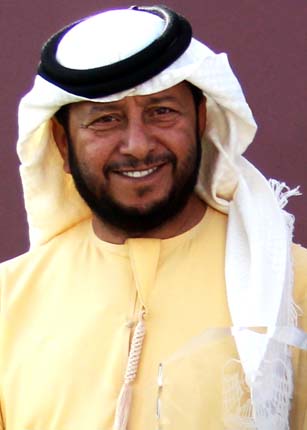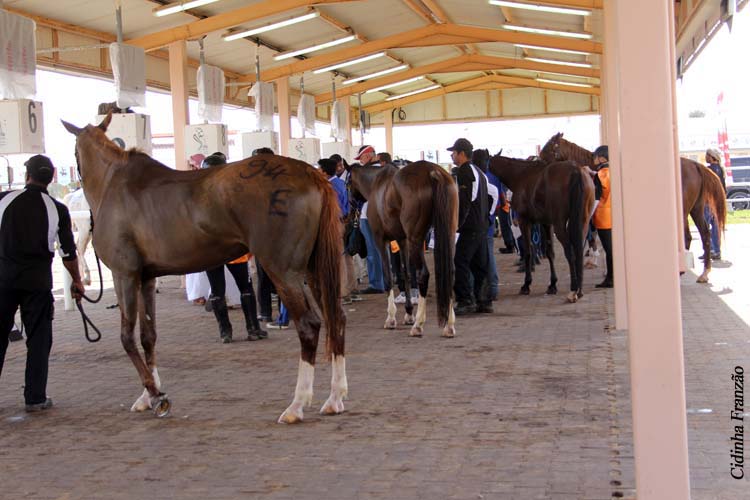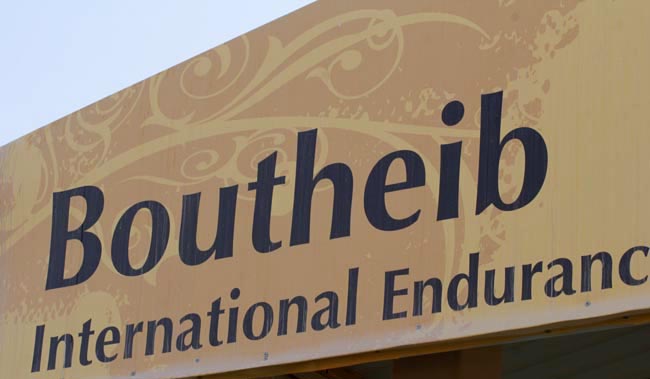Bouthieb (UAE): Why and how does it work?
|
 |
For years Sh Sultan bin Zayed Al Nahyan had been criticizing what he calls the "flat endurance race", a usual deviation of the discipline in the UAE (including Bouthieb until the creation of the new rules this season). The suspension of the National Federation of the UAE, proved him right and he saw an unparalleled opportunity for a change while others have felt humiliated or made themselves angry and even revengeful. He then asked that we provide him with measures based on one main objective that can be summarized by "kill the speed, not the horse", so for him there is a clear cause and effect relationship between the two (which is also today what the FEI claims loud and clear). Noting that the speed mentioned above increases with the value of the prizes that are given to the winner at the end of the competition and that the international rules alone as they are applied would not suffice to redress the situation (as one can see), we developed together the new rules that give such dramatic results. |
WHAT ARE THE MEASURES TAKEN?
The double question at the heart of the matter was: how to kill the speed that kills, and how to educate the competitors so they could understand and stop forgetting that the horses are not interchangeable motorbikes.

From assumptions to reflections, we have come to set up a system based on four main axes:
- To reduce speed by strongly tightening the FEI conventional parameters such that makes it, for example, simply impossible to gallop 40 km at 40 km/h while forgetting everything else.
- To establish a joint system taking into account the welfare of the horse in competition by setting up a system of points grading the rider's ability to manage his horse safely (Best Riding Challenge).
- To reward the joint system much better than the traditional classification to make it a more "attractive" component in order to redirect people's attitudes with the help of financial gain.
- To include controlling rules accompanying the determination to return to a healthy sport and supporting the general education purpose.
So we have somehow responded to the double question by creating a dual system.
TIGHTENING THE "TRADITIONAL" PARAMETERS
One does realize, out in the field, that the FEI rules alone as they are implemented have not solved the problem of speed for speed sake and that some excesses continue to exist.
It was therefore necessary to "work hard on them" and to add something more.
We forget too often that the FEI schedules are special conditions contracts for the rides and that it is possible and legal to amend the general rules to a certain extent.
Many think that the limit of 64 bpm is an obligation while it is clearly stated (in particular with the reformulation made during the revision of the 9th edition) that this limit is valid if nothing more binding was written in the schedule. For 2 years in Bouthieb this limit has been lowered to 60 bpm and has been given this season an additional turn of the screw fixing it at 56 bpm.
This has a clear impact on the recovery time which might thereby have increased more than the speed would have been reduced by this provision. We would then have had horses still going too fast but with an extended recovery time to compensate for the lowering of the authorized heart rate.
We therefore reduced the presentation time in conjunction (which is also possible within the framework of the international regulations, provided it is written in the schedule or made clear during the briefing). Lowering this to 10 minutes, together with the decrease of the maximum heart rate, inevitably has an impact on the speed on the track. For example, it was found impossible to exceed the 23-24 km/h limit thanks to this double provision.
These two amendments were subjected to consultation with the FEI that confirmed the regulatory possibility.
SETTING UP A JOINT SYSTEM for PROTECTION
Reducing the speed is good, but it is not sufficient to put the welfare of the horse at the center of the riders' preoccupations.
We know that many sports include penalty points systems that interfere with the concept of speed. It is particularly the case in cross country tests, in eventing, or in driving events.
Among the solutions found by the national federations for the initiation and training of endurance riders, there is one that we found as a source of inspiration which best shows the behavior of learning riders. it is the Belgian system in which a series of penalty points are awarded depending on the speed, the recovery time, the heart rate, etc. We see that this system of penalties reflects the ability of the rider to manage the horse, which is, or should be, the goal of any endurance training.
Built on the basic idea of this system, several methods have been developed to account for the "management" of the horse by the rider.
A systems of points to be awarded, based on multiple criteria, was eventually implemented as follows:
- Speed: points are awarded depending on the speed. 20 km/h give the maximum number of points. Exceeding this limit is worth zero. Below 20 km/h, 1 point per km/h is lost.
- Recovery: the number of points is inversely proportional to the time and is growing faster than the speed points and heart rate points. 1 minute gives the maximum number of points. 10 minutes is the maximum time allowed and earns the minimum number of points. A time above 10 minutes is eliminatory.
- Heart rate: again the number of points awarded is inversely proportional to the heart rate. 56 bpm are eligible for 1 point and it increases gradually as the frequency lowers. More than 56 bpm is eliminatory.
- Gait: The gait also comes into play in the awarding of points, but to a lesser extent. There are just two possibilities: "A" gives the maximum and "B" is the minimum, "C" being eliminatory by definition (lameness).
- Metabolism: out of the 6 usual criteria, we kept 3 considered as less "subjective", i.e. mucous membrane, capillary refill and girth / whithers / back (pain, injury). The system operates in such a way that 3 "A" (or "1") gives the maximum points, 2 "A" (or "1") and 1 "B" (or "2") gives one less, and so on. A "C" on girth / whithers / gives zero point whatever the result of the other two criteria (which makes sense because such a horse, having wound or pain, should not leave for another phase anyway).
This applies continuously during the competition and not solely on the end result, in order to be a permanent concern.
Considering the timing technique, this obviously complicates the situation, and it is impossible to manage this data without a sophisticated automatic program.
BALANCING the prizes ACCORDING to the aim in view
The two systems are not only parallel but also in constant interrelation during competitions.
We now get two rankings at the end of the competition: the traditional FEI classification with the tightened constraints as explained above, and the points classification that reflects the good management of the horse with regard to its welfare and protection throughout the ride.
To keep the FEI ranking while promoting the point’s classification, the overall allocation is apportioned as follows:
- FEI classification: 30%
- Points classification (non FEI): 70%
This distribution makes the points classification very attractive from a financial point of view. Competitors try to gain as many points as they can while aiming at arriving first, but their preference goes to the highest endowment. The ideal is of course to be ranked first in both systems. The winners in this arrangement are certainly the horses.
Gradually a new perception appears, a new way to compete. It is no longer only to arrive first, even with a horse on the verge of collapsing, but to arrive better.
From the viewpoint of the game itself, more calculation and a different strategy are required. This is a true revolution that has, and will, affect the training mode and the type of horses and, ultimately, breeding itself.
One can see trainers get hooked and change their ways. Actually the goal is to win in both systems, i.e. arrive first on the finish line while having the best number of points. This can only be done by adapting to the new deal.
The game becoming more difficult because it is more subtle is all the more interesting. It is, moreover, entirely consistent with the spirit of endurance that is to win while preserving one's mount (which is theoretically contained in the classical interrelation between heart rate and speed).
Reeducating thanks to a new set of rules
We have seen that all this aims at preserving the horse's welfare and rebalancing the scale of values in the participants' minds.
But we cannot end things here as it would not be enough if we did not put into perspective all the different ways of behaving during a competition. Therefore strict rules were set up to accompany the new provisions mentioned earlier.
We will only list a few here:
- the control of the number of crew cars;
- the end of the mixing of cars and horses on the tracks (existing in Bouthieb for 3 years running);
- the establishment of fixed water points and the banning of continuous watering;
- the prohibition for pedestrians on being on the horse track instead of on the water points;
- the prohibition of the urging on or encouraging the horses from the crew cars;
- the introduction of briefings, which did not exist up to now;
- the obligation to keep the grooming area clean;
- the establishment of a network of surveillance cameras with recordings (including on the trotting lines);
- unexpected controllings of the identification microchips during the competitions;
- the strengthening of weight controls;
- the control of identities on the track in case of doubt;
- unexpected checkings of the equipment and harnesses;
- close examinations of the hold time areas;
- etc.
This set of measures aims at creating a framework for a return to the normal conditions for the practice of endurance.

Bouthieb: a solution to the crisis
As we know, for having heard it many times, including from the mouth of the authorities in charge of international endurance before the 2014 World Equestrian Games in Normandy, endurance is supposed to suffer from its own success and exponential growth.
it is an explanation which is not satisfying. The arrangements decided in a rush just before the aforesaid WEG with effect on August 1st 2014 have clearly not succeeded in putting an end to the excesses observed, which they were aiming to fight.
Something else than predominantly repressive changes was obviously needed.
The new rules implemented in Bouthieb, besides the fact that they are concrete and come from the forces that make the discipline live daily on competition grounds, are incentive and not repressive. This is another way of doing dictated by the reality of the human mind.
We can see their immediate efficiency and we will observe equally positive future impacts on attitudes and ultimately the welfare of horses and the entire sector. The measures implemented are in no way contradictory to the aims of the FEI whose constitutive genes are sport and the welfare of the horse even before sport.
And the question is: what could prevent the spreading of protocols similar to that developed with the success that we know in Bouthieb? This can be done under the patronage of the FEI which we see now with satisfaction ready to act with a new strength in the light of this successful example.
One can also wonder if it would not be time to take a new look at the International Regulations and the entire discipline from the example given today by Sh Sultan and the team working with him considering these exceptional results. Endurance is more or less in a moment of uncertainty and many around the world deplore what it has become of it compared to its founding ambitions.
Can we imagine a reflection on the appropriateness of amending the international endurance rules to participate in creating a better frame giving it a more positive public image, replacing the one currently criticized? Endurance does not deserve it because it is a great discipline, provided the "players" are willing to improve it everywhere.
 Text: François Kerboul -
FEI 4*
Text: François Kerboul -
FEI 4*
Enduroonline.com.br
- © Copyright 2008 - Todos os direitos reservados. |

